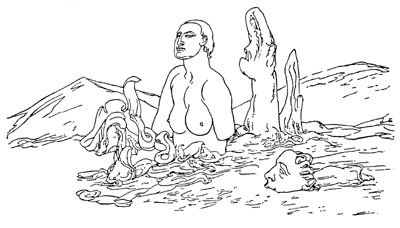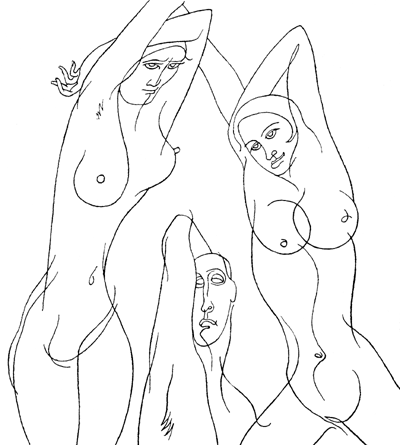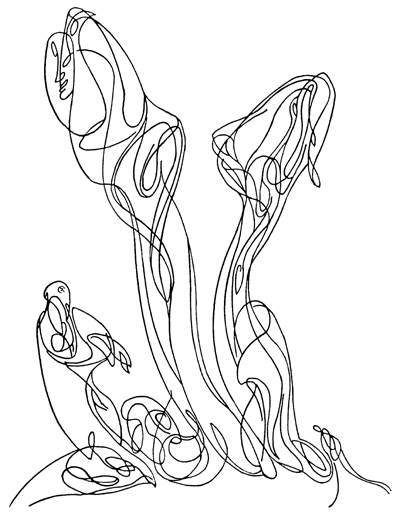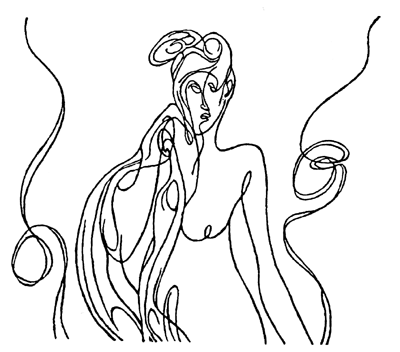Austin Osman Spare
The Mystery of an Artist
Hannen Swaffer

Mr Swaffer has long been an admirer of the art of Austin O. Spare, and his article on this man of genius is illustrated from drawings in his private collection. Mr Spare draws and paints to please himself, and has no complaints to make about being “ignored.” But if Mr Swaffer is correct in believing that posterity will value Mr Spare’s work, we wonder what excuse the art critics will have? After all, they are supposed to know real art when they see it.
|
Illustrated by Austin O. Spare
[Automatic drawings by Mr Spare from Mr Swaffer’s collection.]
|
London Mystery Magazine
Vol. 1 No. 5, Hulton Press
|
For years I have wondered what is the mystery — or rather what are the mysteries, for there are several — of Austin Osman Spare? Why is it that an undoubted artistic genius, forsaking the fleshpots and the salons of Upper Bohemia, lives in an ill-furnished cellar, usually full of stray cats, off the Brixton Road, rather than among the artiness of Chelsea or Bloomsbury?
Why did a man who, when only seventeen, was described as “a genius” by Sargent, turn his back on a profitable career and live among the South London workers from whom he sprang, selling to them for as little as £5 paintings that posterity may hail as masterpieces? Why, when the Royal Academy might acclaim the less unconventional of his works, did he recently hold an exhibition in a Walworth Road pub? And what does he mean when he talks of his “automatic drawings” and “sorcery,” and of “the spirits of dead artists” who, he believes, draw and paint through him?
Perhaps I can explain all this more than anybody except the artist himself. I am a collector of Spare’s works, and it is to me that, in long talks, he has unburdened himself and spoken of his theories about the use of pencil and paint, his dreams and his utter lack of ambition.
It was in 1904, when going home on a tramcar to Denmark Hill, I first saw the name of Austin Spare. It was on a poster outside the Southwark Library, in Walworth Road. Stopping my journey, I went inside to see a show of drawings by a boy of sixteen (the son of a City of London policeman), who had, a year before, had a picture accepted at Burlington House, where he was the youngest exhibitor in its long history. “Spare has already done enough to justify his fame,” G.F. Watts then said of him.
All I can remember of this collection of drawings is their extraordinary rhythm of line and their arresting originality. But the experience, and the artist’s name, I never forgot. Years passed, and it was perhaps about 1926 that he wrote inviting me, a perfect stranger, to see his pictures in a working-class tenement near the Elephant and Castle. He had been painting the local characters, the street women and the hawkers, preferring them as subjects to wealthy patrons — this although Lord Howard de Walden and Sir Frank Brangwyn also went along and bought some of his works — and also experimenting in a new style of his own, one that he now calls “siderealism.”
This gives a name to his method of giving a portrait an odd perspective, attenuating the face either horizontally, perpendicularly, or with an obliqueness. This gives a painting a sort of stereoscopic value, exaggerating but not destroying the likeness.
It was in that worker’s flat, surrounded by the homes of the humble toilers whom he made his friends, that he first talked to me of the occult, claimed that he had drawn pictures — I possess two of the best of these — when he was asleep, and said that, after long experimentation, he had actually caused rain to fall in his bed-sitting-room. He lived in poverty but contentedly, wrapped in his thoughts, happiest among the workers of Southwark, where he was born, and to which, he felt, he belonged.
Then came the war of 1939. Intent only on his work, he stuck out the Blitz, as did so many of his fellow-Cockneys, sleeping for months over an unexploded time-bomb until, in May 1941, bombing and fire wiped out his studio flat, destroying in a second or two his home, his art, the materials of his craft and his health. His right hand was paralysed, and, because official assistance was both late and scanty, he actually lived for five months of the winter of 1946 on only nine shillings! Too proud to ask for help, he kept me ignorant of his plight. When, at last, we met again, he was ill and in rags.
Since then, gradually recovering the use of his fingers, he has held his exhibitions in working-class districts, selling at working-class prices, scorning the patronage of the wealthy, and preferring to take a love of art into the homes of the poor.
There now hang on one of my walls seven of his paintings, each so different in style and character that it is almost impossible to believe that the same hand was responsible for any two of them. And there rest on a table in my sitting-room overlooking Trafalgar Square three sketchbooks full of “automatic drawings” unique in their mastery of line, unique, too, in their daring of conception.
Two other pictures that I possess were drawn by Spare in the darkness, by some dead artist, he believes. Both are psychic, not only in origin, but in subject. Although, unfortunately, the extremely delicate quality of the pencil work makes them unsuitable for hanging — you have to get quite close to them to see their details — I regard them as almost incomparable specimens of draughtsmanship. Both apparently illustrate the evolution of souls in a sphere of existence wider than our own. Each has beside its title — “Dissolution of Consciousness” or “The Ascent of the Fallen” — the words “automatic drawing.”
“When you write on the back of some picture ‘automatic drawing,’ what do you mean?” I asked him once.
“It simply means to me something my conscious mind was not cognizant of when I was doing it,” he explained. “I know more about it when I’ve done it than while I was drawing. That is, I become conscious often when I have committed myself on paper. Otherwise, it would not be automatic. My subconscious mind might be aware of it, but not my conscious mind.
“The best illustration I can give is that, very often, when I’ve been working, I’ve not known what I was doing. I was working automatically. Then I’ve started to come back to normality, to normal consciousness, and found the room was quite dark, and that I’d been working away in darkness in which I could not see.
“The light has failed, perhaps, as I have been working, and I’ve gone on working in the dark. My speed has been fantastic. To use a metaphor, I have worked almost with ‘the speed of light.’
“In one of the books of automatic drawings you bought, there are two ‘deliberate ones,’ to show the difference. They were all done in about four hours, the whole book, all except the last two on which I superimposed my conscious mind. I’ve begun the others purely automatically. I have let my hand do anything. If, when it was done, a form has suggested a tree, I’ve made it more obviously a tree, with just a few added strokes. If it has suggested an animal or a figure, I’ve filled it in with a minimum of circles or curves.
“During the automatic period, I am obsessed or possessed by the spirit of some artist, perhaps a dead artist. I don’t exactly know. The only evidence I may have is that it’s like Dürer or Blake, or like someone I’ve never heard of.
“Many artists, authors and musicians are partly automatic in the early stages of their work. They function in a quasi-consciousness, which is slightly different to subconsciousness. All creative people are born with this gift, on which learning and training can be superimposed. Like any other faculty, or ability, it can be cultivated.
 |
|
In contrast with the automatic drawings illustrating this article, you see on this page a conscious study in movement by Austin O. Spare. All we can do here is to give a hint of his mastery of line. To appreciate fully his genius one must see, and if possible, live with his paintings.
|
In contrast with the automatic drawings illustrating this article, you see on this page a conscious study in movement by Austin O. Spare. All we can do here is to give a hint of his mastery of line. To appreciate fully his genius one must see, and if possible, live with his paintings.
“I define ‘automatism’ in art or writing as something in which the conscious mind is either occupied by some exterior thing or is totally unaware of the activity of the hands on the mind.”
Even when a youth in his middle teens, Austin Spare drew abstract subjects, pictures of chaos, for instance. “Perhaps it was morbid,” he says. “Some might have been by me. Some might have been the work of anybody. Then I published a book called Earth Inferno, using for the wording I illustrated my own version of Dante. That made a Press stunt. All newspapers hailed me as ‘a genius.’ I had five hundred copies printed, and all were sold. The book cost five shillings. I coloured some of them and sold them for a guinea.
“I went on with black and white for perhaps five years. I made a living. A few years before the war of 1914, I published a book called The Book of Pleasure, which gave me a very big Press. It was a book on mysticism. Sir Claude Philips, of the Daily Telegraph, gave me great praise and the other papers copied him. That sort of established me as a mystic artist. I was doing quite well. Then I edited a magazine called Form, which was literary and artistic.
“When the war broke out, I joined the Army. When I left the Forces, the world was a very different place. Lots of things had changed. I found it very difficult to keep going on with what I had been doing. That pushed me into the abstract world — and there I have more or less remained.
“As for a glimmering of a knowledge of the occult, I have always had it in me from my childhood. It developed most just before the nineteen-fourteen war and afterwards.”
“You accept, you say, the explanation that, in some way you don’t understand, you are influenced by the other world?” I said to Spare.
“Definitely,” he replied; “but I don’t think it can be understood. You can tell when I have been influenced, by the difference in the styles of my work. Some are just portraits. Some are pure realism, otherwise pure surrealism. Some are symbolic, some a mixture.”
“Do you believe in black magic?”
“Call it what you like — sorcery, if you choose. I think that’s the most generous word. Still, I do not believe in black or white magic any more than I believe that black and white are the only two colours in the world.”
Then I must tell you of Spare’s ability to “tell fortunes” by means of a pack of cards which he has specially designed and painted for himself. “I have given it up,” he told me, “because I dare not tell people what I see in their future. I do not like hiding the truth — and yet the truth cannot often be told, for I seem to see all of it. And, in the unlived lives of some people, I have seen stark tragedy.
“The ability to ‘read the cards’ first came to me when I was a boy, through an old lady. She lived to be a hundred and one. A friend of my parents, she used to tell my fortune when I was quite young. She never accepted money. She was so accurate and so detailed in her forecast of future events that everybody was very impressed with her. She was married to a doctor; but she had gypsy blood in her veins. She was one of the finest women I ever met or desire to meet. She was full of love and kindness towards everybody. She was like a child. She lived in a very tough neighbourhood, and the roughest characters respected her.
“She impressed me as a person. Even when she died, she seemed to me no older than when I first met her. Forty years before I took some famous people to see her, people about whom she knew nothing, but about whom she could see all. She was a natural hypnotist. She would say, ‘Look in that dark corner,’ and, if you obeyed, she could make you visualize what she was telling you about your future.
“I once took Clifford Bax to her home. She didn’t even know his name. Yet she told him things about which she could not have been informed by anybody. She told him he would marry twice, and how long he would live. He was very impressed.
“After I had taken Mabel Beardsley, sister of Aubrey Beardsley, to see her, she told me privately — she was too kind to tell the woman herself — that she would be dead in two years. She died two years later in a nursing home — of cancer, I think, although she had not been told what would happen, but was given courage and good heart. About her forthcoming illness, the old lady just said, ‘Be very careful about your health.’ With me, though, she used to be quite frank. She told me all the major events of my life. When I’ve told a fortune, I have always wanted to go to sleep for about four hours. The old lady could do hundreds without getting tired.”
Austin Spare dismisses many of the stories about ghosts, saying that, in a country lane in the dark, “a tree can look like a spook.” On the other hand, he says, “The difference between that and a real experience with a ghost is the difference between seeing a picture of a tiger and meeting a real tiger.”
Talking of his first personal experience of a ghost, he says that, because Monsignor Robert Hugh Benson had a haunted room in his house at Huntingford, “I was put in the room and left in it. While lying awake, I look round and saw the door open. I got out of bed and closed it, even slipping the bolt. Looking round again, about five minutes later, and merely out of curiosity, I saw the door had opened again. This time, I had the feeling of something coming towards me. It went right through me. I did not see anything. But someone spoke to me. It seemed as if my hair stood on end. It was like a mass of electricity going through me.
“I heard, ‘Is that you?’ or ‘Are you there?’ and then whatever it was passed through me and out of the window. It was an old voice that spoke to me.
“The legend goes that some elderly man had murdered his wife while she lay in bed in that room and climbed out of the window. I knew nothing about any of it, for Benson’s friends had specially refrained from discussing occult things before I went to bed. His friends had had a similar experience in that room.
“Not that I frequently see ghosts, although I have painted them. Always after seeing them or feeling them, I feel very cold; there is a lowering in the temperature even in the room itself. That is the chief physical effect on me. I am very subject to feeling change of atmosphere; but I have never been afraid of the dark, or bogies, or anything like that.”
It was after a bad bombing near the Elephant and Castle that Spare saw coming towards him, one day, a whole crowd of forms that seemed to be real living people. He was told afterwards that it was the very spot where many had been killed just before.
Well, it is in this world of fantasy and fact, all mixed up, that Southwark’s art genius who won’t be recognized lives, in his cellar, among his adopted cats, and with working folk as his friends in the clubs and the pubs. He is not only among them: he “belongs,” and is quite content. A few art-lovers like myself search him out and offer him commissions. But, rejecting them, he paints to please himself. He is his own master, his own appreciator, his own critic.
“I have had a hard life,” he says, “but I blame nobody but myself. I am responsible for my own misfortunes. I am rather apt to butt at a brick wall at times, and find, in the end, I cannot do any good about it. I cannot change things, so I give it best.”
It was in 1936 that he wilfully rejected a chance of international fame. A member of the German Embassy, buying one of his self-portraits, sent it to Hitler. The Fuehrer was so impressed, probably because the eyes and the moustache were somewhat like his own, that he invited Spare to go to Germany to paint him. Spare, instead, made a copy of it, which now hangs on my wall, dominating by its arrestiveness everything else in the room. Written at the top is the reply that Spare sent to the man who wanted to master Europe and dominate mankind. Here is the reply that a poor artist sent to the overlord, the modern Attila, the man who sought to enslave us all:
“Only from negations can I wholesomely conceive you. For I know of no courage sufficient to stomach your aspirations and ultimates. If you are superman, let me be for ever animal.”



